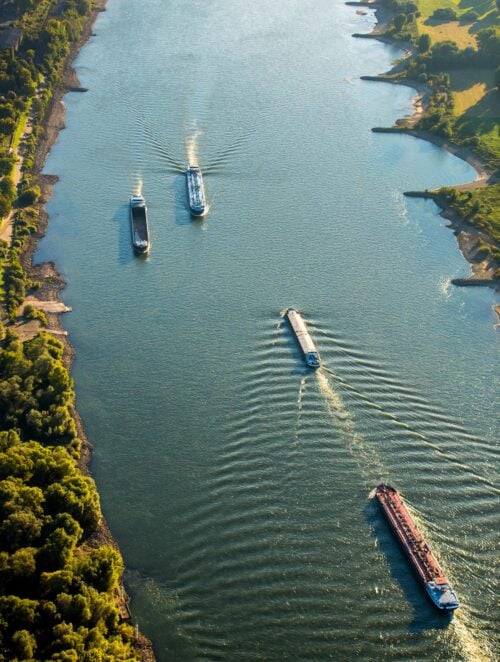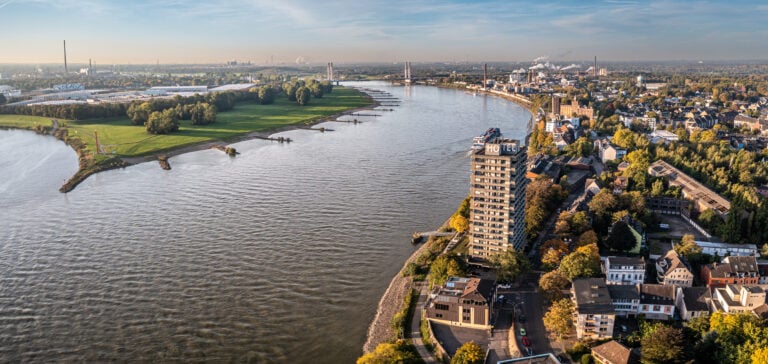At the heart of North Rhine-Westphalia in Germany, Duisport leverages its prime location at the confluence of the Rhine and Ruhr rivers. However, it’s not simply about geography; it’s the port’s proximity to Germany’s largest industrial regions and its seamless integration with major seaports like Rotterdam and Antwerp that makes it indispensable to European logistics.
Unlike seaports, which are often limited by their access to maritime routes, Duisport’s inland location is a logistical advantage, placing it at the crossroads of Western Europe, Central Europe, and key industrial areas. This makes it uniquely capable of handling multimodal transport—from rail and road to waterways—helping businesses reduce transport times and costs across Europe. In fact, over 60% of Europe’s consumer goods pass through these networks.
Rail connections with China: the heart of global trade
Perhaps Duisport’s most significant transformation in recent years has been its role in China-Europe rail trade. This is not just a footnote; Duisport has established itself as the inland logistics hub connecting China’s manufacturing key players with European markets. With 60 trains arriving weekly from Chinese citieslike Shenzhen, Chongqing, and Wuhan, Duisport is a key player in the China-Europe Railway Express.
But it’s not just about volume—it’s about speed. As industries look to cut shipping times, Duisport’s rail connections allow goods to move between China and Europe in 12-16 days, offering a faster, more cost-effective alternative to sea routes that can take up to 45 days. This ability to expedite logistics is a game-changer for just-in-time manufacturing and e-commerce sectors, which rely on fast and reliable delivery windows.
A green revolution: sustainability as a strategy
With logistics often being a carbon-heavy industry, sustainability isn’t just a buzzword at Duisport—it’s part of its core strategy. By committing to carbon neutrality by 2045, Duisport is leading Europe’s logistics sector into a greener future. This initiative is more than just about reducing emissions; it involves a radical transformation of the port’s infrastructure.
Take the newly opened Duisburg Gateway Terminal (DGT) — Europe’s largest trimodal container terminal. Not only does this terminal expand the port’s handling capacity by 850,000 TEU per year, but it’s powered by renewable energy, with plans for hydrogen-powered engines and a photovoltaic system. These are not just greenwashing claims; Duisport is at the forefront of climate-neutral logistics infrastructure, positioning itself as a model for inland ports worldwide.
Saloodo!: Optimizing pre- and post-haulage
While Duisport’s rail and waterway connections are essential, the port’s efficiency in managing pre- and post-haulage is what ensures goods get from the port to their final destination quickly. This is where Saloodo!, DHL’s digital carrier management platform, shines.
In a world where logistics is becoming more digital, Saloodo! allows DHL to manage their transport needs with flexibility and improving delivery efficiency. It’s especially useful for e-commerce and businesses where speed is essential. Saloodo! provides a vast amount of reliable carrier and the digital toolkit that accelerates the often unpredictable business of road freight.
Expanding partnerships as a gateway to Europe and beyond
In 2024, the port announced a strategic partnership with JSC Ukrainian Railways, aimed at boosting freight traffic between Ukraine and the rest of Europe. This is a significant step, particularly in the context of Ukraine’s growing exports to the European market, and further solidifies

Duisport’s role as a gateway for Eastern European trade. Despite the ongoing war, alternative transport routes have been established to maintain and even increase the flow of goods, highlighting the resilience of supply chains between Ukraine and Europe.
Moreover, Duisport has strengthened ties with the Port of Hamburg, Germany’s largest seaport. Through their collaboration, the two ports are focusing on sustainability and optimizing transport options, ensuring that German ports are leading the way in green logistics. By combining their networks and technologies, these two major hubs are setting a precedent for integrated, sustainable transport across Europe.
Duisport’s global standing
In terms of cargo volume, Duisport is not just another inland port — it is the inland port. Handling 61.8 million tonnes annually, it dwarfs other European ports like the Port of Liège (21 million tonnes) and the Port of Vienna (12.4 million tonnes). This puts Duisport leagues ahead of its competitors, both in Europe and globally. It’s a testament to the port’s ability to handle immense volumes while maintaining its commitment to sustainability and innovation.
The future of Duisport: more than a port
Looking ahead, Duisport isn’t resting on its laurels. Its focus on technological innovation, sustainability, and strategic partnerships ensures that it will continue to lead the way in European and global logistics. Whether it’s through cutting-edge technology like AI-driven logistics, strategic partnerships with ports like Hamburg, or its critical connections to China, Duisport is shaping the future of how goods move across borders. In the world of logistics, where time, efficiency, and sustainability are the new currency, Duisport is not just keeping up — it’s defining the rules.









